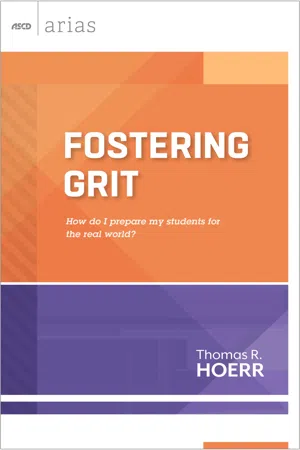
Fostering Grit
How do I prepare my students for the real world? (ASCD Arias)
- 46 pages
- English
- ePUB (mobile friendly)
- Available on iOS & Android
About this book
For too long, educators have focused only on getting students ready for the next test, for the next grade, for graduation, or maybe for college. Students must be prepared to succeed in school, and they must know how to read, write, and calculate. But that's only the beginning. Our job--whether we teach kindergarten, 5th grade, or high school or we lead a school or district--is to prepare students for success in the real world. To do so, we must also teach grit. Grit is a combination of tenacity and perseverance--a willingness to take risks even if it means sometimes failing and starting again. Knowing how to respond to frustration and failure is essential whether a student struggles or excels. Veteran school leader and popular Educational Leadership columnist Thomas R. Hoerr shows what teaching for grit looks like and provides a sample lesson plan and self-assessments, along with a six-step process applicable across grade levels and content areas to help students build skills they need to succeed in school and in life.
Frequently asked questions
- Essential is ideal for learners and professionals who enjoy exploring a wide range of subjects. Access the Essential Library with 800,000+ trusted titles and best-sellers across business, personal growth, and the humanities. Includes unlimited reading time and Standard Read Aloud voice.
- Complete: Perfect for advanced learners and researchers needing full, unrestricted access. Unlock 1.4M+ books across hundreds of subjects, including academic and specialized titles. The Complete Plan also includes advanced features like Premium Read Aloud and Research Assistant.
Please note we cannot support devices running on iOS 13 and Android 7 or earlier. Learn more about using the app.
Information

Why Grit?
Executive Functions and Grit
Research on Grit
- A 2011 New York Times article by Paul Tough titled “What If the Secret to Success Is Failure?” discusses the work of Angela Duckworth, a professor at the University of Pennsylvania who focuses on the importance of grit in an education context. (She took the term grit from the title of the 1969 movie True Grit.) Duckworth first became interested in grit when trying to understand why certain students stay in college despite facing personal hardships and difficulties. (See TEDxTalks, 2009, for a talk on grit by Duckworth.)
- Paul Tough also discusses grit in his book How Children Succeed: Grit, Curiosity, and the Hidden Power of Character (2012), which examines the effect of grit on students who are academically prepared for college but encounter real-world obstacles.
- My own March 2012 Principal Connection column in Educational Leadership is devoted to grit (see Hoerr, 2012).
- The importance of grit is indicated in a 2013 report from the U.S. Department of Education titled Promoting Grit, Tenacity, and Perseverance: Critical Factors for Success in the 21st Century, which expresses concern for students who are learning to “do school but are not developing the life skills to persevere in the face of challenges they will face in the real world” (p. 18). As the report notes, “Educators, administrators, policymakers, technology designers, parents, and researchers should consider how to give priority to grit, tenacity, and perseverance in curriculum, teaching practices, teacher professional development, programs, technology adoption, and out-of-school support” (p. xii). The reason for this is quite clear: “Meta-analyses of a growing body of educational research suggest that these factors can have just as strong an influence on academic performance and professional attainment as intellectual factors” (p. 1).
- In his 2008 book, Outliers: The Story of Success, Malcolm Gladwell notes that grit in the form of devoting at least 10,000 hours to practicing a craft or skill is essential to mastery. (He uses Bill Gates and The Beatles as examples.)
- Carol Dweck champions grit in her book Mindset: The New Psychology of Success (2007). Dweck believes that there are two principal modes of thinking: fixed mindsets and growth mindsets. Fixed mindsets keep intelligence static, avoid mistakes, and prioritize looking smart over learning. Because people with fixed mindsets seek situations in which success is practically guaranteed, they are unlikely to develop grit. By contrast, people with growth mindsets acknowledge that even though mistakes may not be pleasant or make things easy, they help us learn. The grit of those with growth mindsets stems from knowing that the harder they work and the longer they try, the likelier they are to succeed.

Differentiation and Grit
- Process. We can elicit grit in the learning process by having students learn in a way that does not come easily to them. From a multiple-intelligences perspective, this means having students use one of the intelligences that is not a strength of theirs. For example, strong writers might be asked to learn about life during the Renaissance by drawing inferences from paintings or listening to music; interpersonal and gregarious students may be asked to work individually while introver...
Table of contents
- Cover
- Title Page
- Table of Contents
- content
- Encore Divider
- Encore
- References
- Related Resources
- About the Author
- Copyright